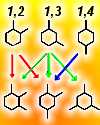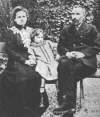
On 20 Apr 1798, Sir William Edmond Logan, one of Canada’s great scientists, was born.
When he founded the Geological Survey of Canada, the country’s geology was virtually unknown. He served as its director (1842-69) and produced the monumental Report on the Geology of Canada (1863), recording 20 years of his research and fieldwork.
In our era, geologists ride over any landscape in 4-wheel-drive trucks, and record their data on laptop computers. Not so for this pioneer geologist!
Read this Obituary for William E. Logan and let your mind picture a return to his time when “From early dawn till dusk he paced or paddled, and yet his work was not finished, for while his Indians—often his sole companions—smoked their pipes round the evening fire, he wrote his notes and plotted the day’s measurements.”

On 20 Apr 1914, Robert Galambos was born, an American physiologist who worked with Donald Griffin, both while students, to confirm that bats use echolocation to avoid obstacles in flight. Today's book pick is: , by , his colleague. The title of this book resulted from a suggestion by that author’s father, and the text grew out of three Trumbell lectures on animal navigation given at Yale University in 1955. How can bats flying blindly detect 1/100 inch wires from several feet away, dodge stalactites in pitch-dark caves, catch insects on the wing or fish in motion just below the surface of the water, and find their way back to their home roost? In this remarkable book, a pioneering scientist in the areas of neurobiology and behavior explains in layperson’s language just how bats can “see” with their ears. After the 1940 discovery by Robert Galambos and Griffin that bats avoided obstacles by hearing echoes of sounds above the range of human hearing, Griffin found bats also detect their insect prey by echolocation. Human echolocation, important to the blind, is the subject of its own chapter.
It is available from Amazon, typically about (As of earlier time of writing - subject to change.)
 | The dogma of the impossibility of determining the atomic constitution of substances, which until recently was advocated with such fervor by the most able chemists, is beginning to be abandoned and forgotten; and one can predict that the day is not far in the future when a sufficient collection of facts will permit determination of the internal architecture of molecules. A series of experiments directed toward such a goal is the object of this paper. |
 | Questions that pertain to the foundations of mathematics, although treated by many in recent times, still lack a satisfactory solution. Ambiguity of language is philosophy's main source of problems. That is why it is of the utmost importance to examine attentively the very words we use. |
 | The determination of the relationship and mutual dependence of the facts in particular cases must be the first goal of the Physicist; and for this purpose he requires that an exact measurement may be taken in an equally invariable manner anywhere in the world… Also, the history of electricity yields a well-known truth—that the physicist shirking measurement only plays, different from children only in the nature of his game and the construction of his toys. |
| Before you look at today's web page, see if you can answer some of these questions about the events that happened on this day. Some of the names are very familiar. Others will likely stump you. Tickle your curiosity with these questions, then check your answers on today's web page. | |
| Births | |
 | Gerald S. Hawkins, born 20 Apr 1928, was a British astronomer who identified an ancient location in England to be a prehistoric astronomical observatory, built thousand of years ago. He identified 165 key points in the complex and found that many of them very strongly correlated with the rising and setting positions of the sun and moon. He used a computer to show that there existed at a pattern of alignments with twelve major lunar and solar events. Which site did he identify as an ancient astronomical observatory? |
| Deaths | |
 | Ignatz Venetz (1788-1859) was Swiss geologist who was one of the first to propose that vast glaciers once covered a substantial portion of the earth’s surface. What evidence did he use to support this claim? |
 | Franz Karl Achard (1753-1821) was a German chemist who invented a process for the large-scale extraction of table sugar (sucrose) from a certain plant, and in 1801, opened the first factory to process, in Silesia (now Poland). At first, though simple, the method was costly, due to the amount of fuel used. What plant was the source of sugar in his process? |
| Events | |
 | On 20 Apr 1902, Marie and Pierre Curie isolated one gram of radium chloride, the first pure sample of the radioactive element. They had refined it from a quantity pitchblende ore Was the quantity of ore they processed to isolate this first gram of radium: (a) 8-lb (b) 80-lb (c) 800-lb (d) 8000-lb (e) 8 tons? |
 | On 20 Apr of a certain year, the first picturephone transcontinental call was made between New York City and Anaheim, California. The device consisted of a telephone handset and a small, matching TV. It allowed telephone users to see each other in fuzzy video images as they carried on a conversation. In which decade was this first transcontinental picturephone call made? |
 | On 20 Apr 1862, the first test of a process to treat liquids to prevent decay or fermentation was demonstrated when sealed jars were opened at a meeting of the French Academy of Sciences. They contained dog’s blood and urine, sealed the previous month (3 Mar), and since then had been maintained at an elevated temperature of 30°C. This suggested the possibility of heating foods sufficiently to kill germs without significantly altering their chemical composition. The process was applied to beer. Named after its inventor, what word is now used for this process? |
Fast answers for the previous newsletter for April 19: actinides • Norwegian • Pierre Curie • …by Means of Natural Selection • the decade including the year 1943.
 If you enjoy this newsletter, the website, or wish to offer encouragement or ideas, please send feedback by using your mail reader Reply button.
If you enjoy this newsletter, the website, or wish to offer encouragement or ideas, please send feedback by using your mail reader Reply button. Your click on a Facebook, StumbleUpon, or other social button on the site webpages is also a welcome sign of appreciation. Thank you for using them.
© This newsletter is copyright 2020 by todayinsci.com. Please respect the Webmaster's wishes and do not put copies online of the Newsletter — or any Today in Science History webpage. (If you already have done so, please remove them. Thank you.) Offline use in education is encouraged such as a printout on a bulletin board, or projected for classroom viewing. Online, descriptive links to our pages are welcomed, as these will provide a reader with the most recent revisions, additions and/or corrections of a webpage. For any other copyright questions, please contact the Webmaster by using your mail reader Reply button.
--
If you do not want to receive any more newsletters, Unsubscribe
To update your preferences and to unsubscribe visit this link
Executive Real Estate Business Class
-
"It was like a man with wings. It wasn't like anything you'd see on TV or in a monster movie." ...
About the publisher
Search This Blog
Blog Archive
-
▼
2021
(585)
-
▼
April
(57)
- On This Day for April 30 - George Washington inaug...
- Newsletter for Friday 30 April.
- On This Day for April 29 - British royal wedding, ...
- Newsletter for Thursday 29 April.
- On This Day for April 28 - Benito Mussolini execut...
- Newsletter for Wednesday 28 April.
- On This Day for April 27 - Independence for Sierra...
- Newsletter for Tuesday 27 April.
- On This Day for April 26 - Chernobyl nuclear accid...
- Newsletter for Monday 26 April.
- On This Day for April 25 - Hubble Space Telescope ...
- See How They Tracked Down Bin Laden
- Newsletter for Sunday 25 April.
- On This Day for April 24 - Installation of Pope Be...
- Newsletter for Saturday 24 April.
- On This Day for April 23 - Voting for Eritrea's in...
- Earth Day Bonus: Become a Climate Action Expert
- On This Day for April 22 - First Earth Day, Miguel...
- On This Day for April 21 - French elections held, ...
- Newsletter for Wednesday 21 April.
- On This Day for April 20 - Explosion on the Deepwa...
- Newsletter for Tuesday 20 April.
- On This Day for April 19 - American Revolution beg...
- Newsletter for Monday 19 April.
- On This Day for April 18 - The midnight ride of Pa...
- Newsletter for Sunday 18 April.
- On This Day for April 17 - Canada Act proclaimed, ...
- Newsletter for Saturday 17 April.
- On This Day for April 16 - Harriet Quimby's flight...
- Newsletter for Friday 16 April.
- On This Day for April 15 - Sinking of the Titanic,...
- Newsletter for Thursday 15 April.
- On This Day for April 14 - Abraham Lincoln shot, J...
- On This Day for April 13 - Alfred Dreyfus imprison...
- Newsletter for Tuesday 13 April.
- On This Day for April 12 - Launch of first space s...
- Newsletter for Monday 12 April.
- John of Gaunt: father of England’s medieval monarchy
- On This Day for April 11 - Napoleon's abdication a...
- Newsletter for Sunday 11 April.
- On This Day for April 10 - Anschluss approved in A...
- On This Day for April 9 - Fall of Baghdad, Jørn Ut...
- Newsletter for Friday 9 April.
- On This Day for April 8 - Celebration of the Buddh...
- On This Day for April 7 - Jack Nicklaus's first Ma...
- Newsletter for Wednesday 7 April.
- On This Day for April 6 - Olympics revived, Raphae...
- On This Day for April 5 - Battle of Maipú, Colin P...
- The history and origins of Easter
- On This Day for April 4 - Martin Luther King, Jr.,...
- Newsletter for Sunday 4 April.
- On This Day for April 3 - Implementation of the Ma...
- Newsletter for Saturday 3 April.
- On This Day for April 2 - Death of Pope John Paul ...
- Newsletter for Friday 2 April.
- On This Day for April 1 - Creation of Nunavut, Ser...
- Newsletter for Thursday 1 April.
-
▼
April
(57)
-
Blogroll
-
About
HistoryFact










0 comments:
Post a Comment